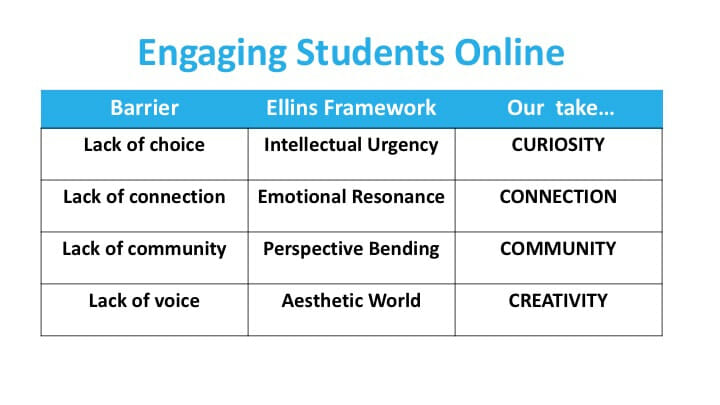Over the past few months, we’ve worked with and talked to hundreds of teachers about the good, bad, and ugly of remote learning. A question that came up over and over was “how do we keep our students engaged in online learning?” This short blog post will begin to tackle that question with a few things we learned from recent publications, insight from teachers, and good ‘ole fashioned trial and error in the classroom.
We hope our thinking supports your own as you are considering how to support all of your students in online learning in meaningful ways.
Barriers to Student Engagement
First, we know that it is important to understand a problem before designing solutions for it. To that end, we will suggest a few ideas around what impedes students from fully engaging in online learning. By naming these obstacles, we can then design our instruction to overcome them.
1. Lack of Choice: With the rapid changes it is often easier to simple assign tasks to students rather than to create meaningful learning opportunities. In a virtual learning environment, students are often not given any choice in assignments.
2. Lack of Voice: While many teachers have kind-heartedly joked about the “mute all” feature in zoom being a benefit, we know that students being able to participate in lessons through dialogue, debate, and simply “thinking out loud” is critical to their learning. Often with online lessons students don’t have the chance to speak or collaborate as they would in the classroom.
3. Lack of Connection: We do know that a very real barrier to instruction is internet speeds and adequate devices for students. While that kind of connection is fundamental, we also want to highlight how lessons online can lack a connection to the students social emotional needs and
4. Lack of Community: The hashtag #inthistogether has been trending for sometime, but it can often feel to students that they are learning in isolation, watching videos and doing assignments that aren’t bringing them back to the classroom community or larger community in which they belong.
A Detailed Definition of Engagement

Now that we have defined the problem more acutely, it’s time to think deeply about the solution. Our own thinking was greatly impacted by the book “Engaging Children” by Ellin Oliver Keene.
She writes about four pillars of authentic engagement and we have adapted them in order to remember more readily. They are Curiosity, Connection, Community, and Creativity. As you can see, these ideas directly relate to the barriers we’ve outlined. Let’s dive in a little deeper.
1. Curiosity: When we are truly engaged we find ourselves asking lots of questions. “Why does this..?” “How come…?” “What if…?” By creating lessons online that pose open-ended questions to students and get them asking them, we spark students curiosity. Getting students to lean in and look a little more closely is critical. One teacher we know used scavenger hunts around the home and outside in order to get her students away from the computer, and up asking questions. Another teacher had students interview family members learning how to ask questions of others as well.
2. Connection: One benefit of learning online was actually “letting students in” to our own homes. We found that students were so interested to learn where our own reading and writing spots were, how we kept ourselves organized and especially what pets we had in the house. Connecting through stories and showing our own inner lives was a tremendous way to keep students engaged. Many teachers found that even adolescents appreciated a “show and tell” moment (of course they didn’t call it that!) during classroom meetings.
3. Community: Providing shared experiences is one important aspect of building community. There are many sites that do virtual field trips, but often the teachers we found that provided simple ways for students to all share an experience kept classroom community culture alive and well. For example, one kindergarten teacher sent a package of seeds in the mail to each student and they all still did their seed planting unit “together”. One middle grades teacher started each session with students by sending them an open ended question ahead of time and then students used FlipGrid to respond to the question and each others thoughts.
4. Creativity: This “pillar” is tied to student voice for us. While it might seem even more silly than doing in person, singing and dancing and infusing visual arts into the online learning experience is not just enriching — it’s elemental! One third grade teacher we worked with had her students writing fairy tales and by the end of the unit they got to play-act them in front of an online audience. Collaborative drawing boards and games helped students to demonstrate their own thinking and build off of one another.

Engagement is caught more than taught
Engaging students is paramount to good teaching. Rather than give you a list of “activities” to do to support student engagement we wanted to give you a framework for thinking about it so that as you design your lessons you can consider whether they help students be more curious, more connected, more knit into community, or more creative. Ultimately we can not lead students if we do not live it and love it ourselves. So teachers, show up yourselves! Be engaged – ask questions, lean in, create spaces for student voice and choice and see how your online learning deepens.
We are here to support you in this work!







